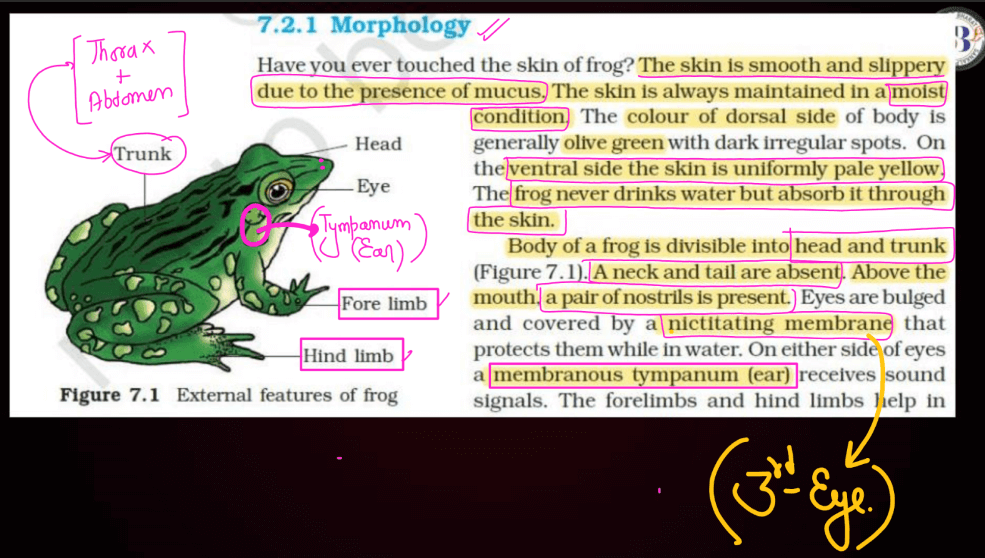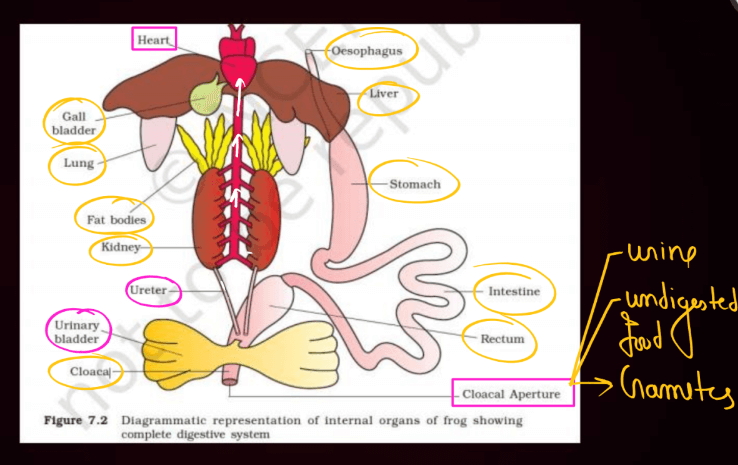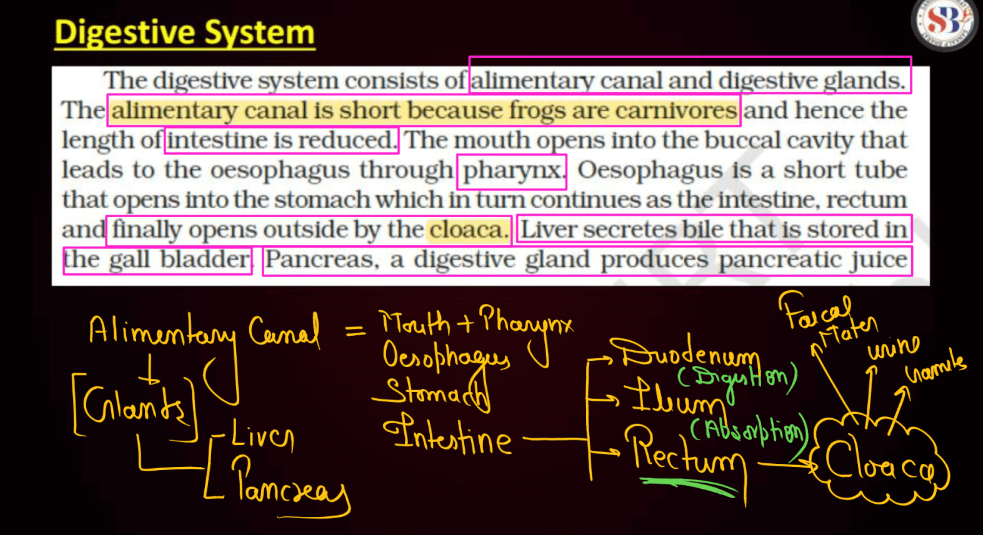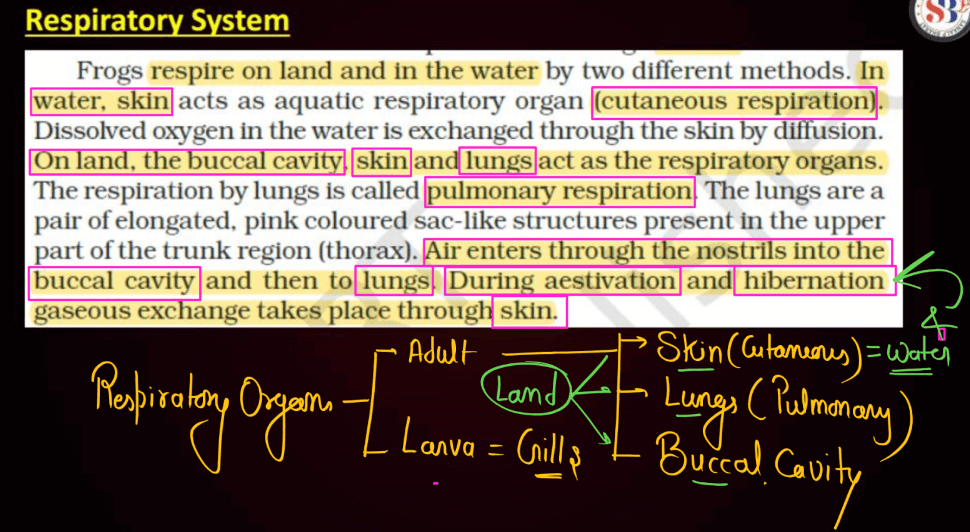Frogs are special animals that can live both in water and on land. They have smooth, wet skin, webbed feet, and strong legs for jumping. When they are babies, they start as tadpoles, swimming in water. As they grow up, they go through a big change called metamorphosis, turning into adult frogs. Frogs are helpful in nature because they eat insects, helping to control bug populations.

You might hear them make croaking sounds, which is how they communicate with each other. Frogs are sensitive to changes in the environment, so scientists study them to understand if the places they live are healthy. Next time you see a frog, remember that they are like nature’s bug catchers, and they have this amazing life cycle of starting as tiny tadpoles and growing into hopping adults with unique croaky voices.
Morphology of a Frog
Frogs exhibit distinct morphology adapted to their amphibious lifestyle. Their skin is smooth and moist, providing a vital respiratory surface for breathing, in addition to lungs. Sporting webbed feet, frogs excel in both jumping and swimming. Remarkably, their hind legs are powerful, enabling impressive leaps, while their front legs are powerful, enabling impressive leaps, while their front legs aid in balance and movement on land. Positioned at top their heads, bulbing eyes offer an expanded field of version, crucial for spotting prey and predators.

One of the most intriguing aspects of a frog’s life is its metamorphosis. Starting as aquatic tadpoles, they undergo a remarkable transformation. Tadpoles possess a tail for swimming and lack limbs but gradually develop into fully-formed adult frogs through stages of metamorphosis. This process involves the growth of the hind legs, absorption of the tail, and the development of lungs for air-breathing. The morphology of a frog exemplifies adaptation to a dual life – one in the water as a tadpole and another on land as an agile, leaping adult.
Anatomy of Frogs
Frogs, amphibians with a unique anatomy, have streamlined bodies adapted for both land and water. Their skin is smooth, thin, and permeable, allowing them to breathe through it. Large, expressive eyes provide an excellent version for hunting insects, their primary diet. Frogs have powerful hind legs designed for jumping great distances. The long, webbed feet aid in swimming, while sticky toe pads assist in climbing. Remarkably, frogs lack a tail in their adult stage. Internally, frogs possess a simple but efficient Respiratory System. They breathe through both their lungs and a specialized skin breathing process called cutaneous Respiration.
Their three-chambered heart pumps blood – rich in both oxygen and carbon dioxide – throughout the body. Reproduction involves external fertilization. Females lay eggs in water, and males release sperm to fertilize them externally. Tadpoles, in the aquatic larval stage, undergo metamorphosis, transforming into adult frogs. In summary, a frog’s anatomy is a testament to its adaptability, enabling it to thrive in diverse environments and transition through various life stages with remarkable efficiency.
The body cavity of frogs accommodates different organ systems such as digestive, circulatory, respiratory, nervous, excretory, and reproductive systems with well-developed structures and functions.
Digestive System of a Frog
The digestive system of a frog is like a journey for its food. When a frog catches something tasty, it gulps it down whole. The adventure begins in the esophagus, a tube that carries the food to the stomach. In the stomach, powerful juices start breaking down the meal. Next stop: the Small Intestine.

This is where the real magic happens. Nutrients from the frog’s energy source. Anything left takes a ride to the Large Intestine, where water gets absorbed, making the waste less watery. Finally, the journey ends at the cloaca, a special exit point for both waste and eggs or sperm. The waste leaves the frog’s body, completing the digestion adventure. So, from swallowing to excretion, a frog’s digestive system is a well-orchestrated process ensuring it gets the most from its meals.

Respiratory System of Frogs
Frogs have a unique respiratory system suited for both water and land. They breathe through their skin, which is thin and moist, allowing oxygen to pass into their bloodstream directly. When in water, frogs also use their lungs to extract oxygen. During breathing, frogs close their nostrils and force air into their lungs by lowering the floor of their mouths.

Internal & External Features of Frogs
- There are over 7,000 known species of frogs, and they come in various shapes, sizes, and colors. Some are tiny, while others, like the Goliath frog, can be as large as a small dog.
- Frogs have special eyes that can retract into their skull and even swallow food using their eyes. This helps them push food down their throats.
- Many frogs have incredible camouflage abilities, blending into their surroundings to avoid predators. Some can even change their skin color.

- The hind legs of frogs are powerful, allowing them to make remarkable jumps. The world record for the longest frog jump is held by a South African frog, capable of leaping over 10 feet.
- Frogs don’t drink water like we do. They absorb water through their skin, which needs to stay moist for them to breathe.
- Certain frogs can survive being partially frozen during winter months. They enter a state of suspended animation until they thaw out in spring.
- Frogs are considered indicator species, meaning their presence or absence can indicate the health of an ecosystem. Their sensitivity to environmental changes makes them crucial for monitoring ecosystems.
To Know more about Frogs: Anatomy, Morphology and Interesting Facts.



 50 Vegetables Name for Kids in English a...
50 Vegetables Name for Kids in English a...
 Food Chain: Definition, Types, Examples,...
Food Chain: Definition, Types, Examples,...
 Human Respiratory System: Definition, Di...
Human Respiratory System: Definition, Di...













